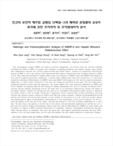

PARTNER
검증된 파트너 제휴사 자료
인간의 유전자 재조합 골형성 단백질-2과 헤파린 혼합물의 골유도 효과에 관한 조직학적 및 조직형태학적 분석
방대한 850만건의 자료 중 주제별로 만들수 있는 최적의 산출물을 해피 캠퍼스에서 체험 하세요 전문가의 지식과 인사이트를 활용하여 쉽고 폭넓게 이해하고 적용할수 있는 기회를 놓치지 마세요
10 페이지
최초등록일 2016.04.02
최종저작일
2010.08

-
 * 본 문서는 배포용으로 복사 및 편집이 불가합니다.
* 본 문서는 배포용으로 복사 및 편집이 불가합니다.
미리보기
서지정보
· 발행기관 : 대한구강악안면병리학회
· 수록지 정보 : 대한구강악안면병리학회지 / 34권 / 4호
· 저자명 : 장원혁, 정진형, 홍기석, 박경주, 임성빈
목차
I. Introduction
II. Materials and Methods
1. Recombinant human bone morphogeneticprotein and Heparin
2. Isolation, culture and verification of adiposestem cell
3. Osteoblastic differentiation culture
4. Determining of osteoblastic differentiation
5. Statistical analysis
III. Results
1. Verification of adipose stem cell lineage
2. Morphologic changes and Naphthol ASphosphate‐fast blue BB reaction
3. Morphologic changes and Alizarin redreaction
4. Alkaline phophatase Activity
IV. Discussion
V. Conclusion
VI. References영어초록
Bone morphogenetic proteins (BMPs) are known to promote osteogenesis, and clinical trials are currently underway evaluating the ability of BMPs to promote bone formation in grafting procedures and fracture healing. Some studies, have independently reported that sulfated polysaccharides particularly heparin, enhance the osteoblastic differentiation induced by BMPs in vitro, and another study demonstrated that heparin enhanced the bone formation induced by BMP‐2 in vivo. This study was performed to examine adipose stem cell responses to rhBMP‐2 alone and rhBMP‐2 with heparin at 0.25, and 25 μg/㎖ concentrations, respectively, in culture media. Adipose stem cells were cultured for 2, 4, and 8 days toward the osteoblastic differentiation in rhBMP‐2 alone and rhBMP‐2 with heparin at 0.25, and 25 μg/㎖ concentrations, respectively, in culture media. Verification of the stem cell lineage was performed in two ways. The first method was a continuous sequential culture until 5th generation. The second method was using monoclonal antibodies for STRO‐1 and CD 90. Naphthol AS phosphate‐fast blue BB staining for alkaline phosphatase was used for verifying osteoblastic differentiation because Alkaline phosphatase activity had been used as an osteoblastic differentiation marker and degree of osteoblastic activity. Alizarin red staining was also used as an osteoblastic differentiation marker because it quantifies the calcium levels in cells or tissues. During the 5th generation culture, cultured cells actively proliferated, and these cultured cells showed a positive reaction to STRO‐1 and CD90 cell surface molecules. Naphthol AS phosphate‐fast blue BB staining and Alizarin red staining were positive in most samples of each group at 2, and 4 days and positive reaction was proportioned to degree of morphological differentiation. In the concentration of 25 μg/ml of heparin, the ALP activity was highest at the 2nd day in the culture, and then the activities of ALP were decreased significantly at 4, and 8 days. The ALP activity was greatest at the 4th day of the culture, and then decreased significantly at the 8th day in 0 μ g/ml and 0.25 μg/ml of heparin concentrations, Adipose stem cells could be differentiated in rhBMP‐2 in culture media, and the addition of heparin to BMP‐2 promoted differentiation of osteoblasts. Moreover, morphological differentiation was associated with the activity of osteoblasts. This study was shown that, when heparin concentration increases, the early differentiation of the cells was brought about, but the early differentiated cells were rapidly progressed to degenerative changes참고자료
· 없음태그
-
자료후기
-
자주묻는질문의 답변을 확인해 주세요

꼭 알아주세요
-
본 학술논문은 (주)코리아스칼라와 각 학회간에 저작권계약이 체결된 것으로 AgentSoft가 제공 하고 있습니다.
본 저작물을 불법적으로 이용시는 법적인 제재가 가해질 수 있습니다. -
해피캠퍼스는 구매자와 판매자 모두가 만족하는 서비스가 되도록 노력하고 있으며, 아래의 4가지 자료환불 조건을 꼭 확인해주시기 바랍니다.
파일오류 중복자료 저작권 없음 설명과 실제 내용 불일치 파일의 다운로드가 제대로 되지 않거나 파일형식에 맞는 프로그램으로 정상 작동하지 않는 경우 다른 자료와 70% 이상 내용이 일치하는 경우 (중복임을 확인할 수 있는 근거 필요함) 인터넷의 다른 사이트, 연구기관, 학교, 서적 등의 자료를 도용한 경우 자료의 설명과 실제 자료의 내용이 일치하지 않는 경우
문서 초안을 생성해주는 EasyAI
